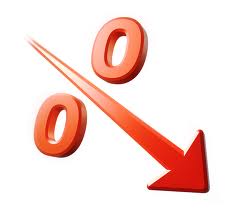Lowering interest rates can potentially boost economic activity as it increases both speculation and exports by devaluating the currency. Its effects, are artificial and temporary, at best. New growth caused by cheaper money must come from somewhere, and as I pointed out in another article “Fiat Currencies” this money comes at the expense of the savers and it automatically sets the stage for an inevitably larger decline than the slump for which it was created to boost.
When Interest Rates are Low, Money Becomes Abundant
 When interest rates are low, money is cheap. Cheap money provides incentive for speculation and punishes people who save. For instance, low interest rates provide the incentive and the means for people to purchase a new home because their mortgage would now be much cheaper than before. This puts extra demand in the real estate market and pushes evaluation up.
When interest rates are low, money is cheap. Cheap money provides incentive for speculation and punishes people who save. For instance, low interest rates provide the incentive and the means for people to purchase a new home because their mortgage would now be much cheaper than before. This puts extra demand in the real estate market and pushes evaluation up.
What is so difficult to grasp is that this growth is artificial; it emerges from a suppression of low rates by central banks. This policy is a boldly inflationary and this “new” growth is caused at the expense of savers who experience a great reduction in purchasing power. In other words, there is subtle transfer of wealth from the savers to the debtors.
Remember that there is nevertheless a temporary increase in activity in some sectors when interest rates are lowered–predictably, in construction and real-estate. This cheap money is used to expand their business operations or for individuals to buy a house. Since we live in a world with finite resources, interest rates cannot be lowered indefinitely. Something has got to give, and the longer that interest rates are artificially held down, the more inflation is created. The result? The need to increase interest rates much higher at a later date, or suffer hyper-inflation.
Another point revolves around currency appreciation. When a currency starts to appreciate against the U.S. dollar, this causes tension for the later local economy, due to setbacks in their higher exports prices. If exports cost more, this will hurt the local economy: production will decline, an eventual repercussion of which is a loss of jobs. To alleviate this situation, central banks lower rates to help devaluate their currency against another currency to make exports cheaper and to therefore stay in business. By central banks playing this self-serving game, currencies become a race to the bottom. In this scenario, the saver is again the loser by the inflationary policies caused by central banks. The effects of low interest rates can become disateous and the reason for a boom and bust economy.
Low Interest Rates Are Inflationary Policies
Everytime someone purchase a home and takes out a mortgage, he/she is expanding the money supply as this money does not come from bank reserves, it comes from mostly “thin air” through a process known as fractional reserve banking. Whether the purpose of central banks lowering interest rates is to increase economic activity, boost exports, or to lower their own borrowing costs, the end result is inflation. In inflationary periods, savers become losers as they end up paying for this artificial stimulation through a loss of purchasing power. Governments prefer this rout of inflation due to the fact that it will get them re-elected, while, if they would do the right thing, by increasing the interest rates to reward the savers, this would be political suicide and cause major economic setbacks and probably mass deleveraging, during deflation. Although, this deleveraging would be the cure to a sick economy, as it sets prices back to equilibrium, and removes any froth from an excess economy.
To continue to part 2 of this article see here.


